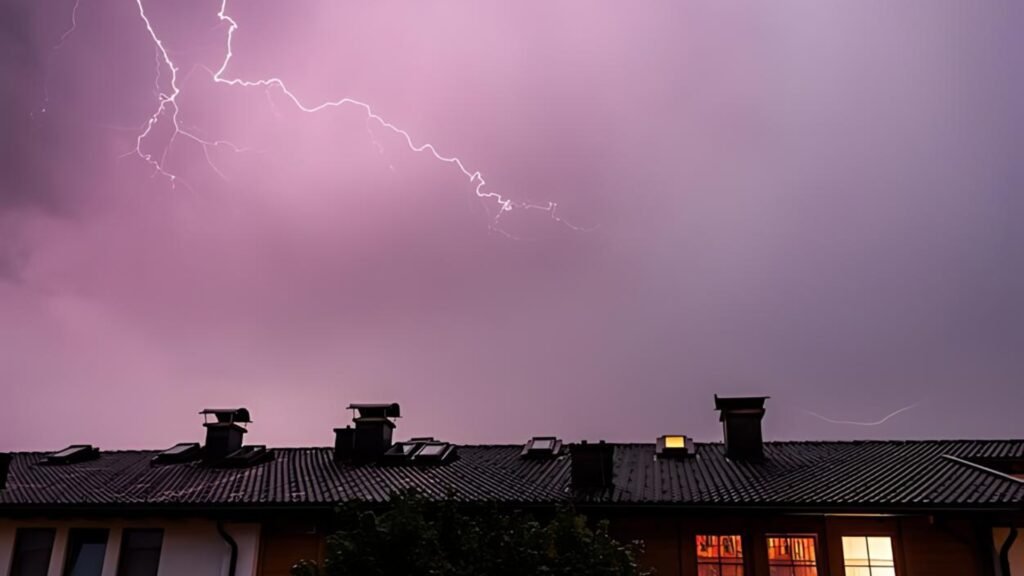In the realm of home construction and safety, concerns about lightning strikes often lead homeowners to question the suitability of metal roofs. This article delves into the commonly asked question: do metal roofs attract lightning? Understanding this interaction is crucial for homeowners considering roof materials, as it impacts both safety and maintenance decisions.
Lightning, a powerful natural phenomenon, strikes objects based on several factors including height, shape, and conductivity. Metal roofs, known for their durability and aesthetic appeal, are often perceived as lightning magnets due to their conductive properties. However, this perception merits closer examination against scientific and practical evidence.
By exploring the myths, realities, and safety considerations surrounding metal roofs and lightning, this article aims to provide clarity and guidance for homeowners. Additionally, it will highlight the role of lightning protection systems and practical steps to mitigate risks associated with thunderstorms. Whether you’re planning a new roof installation or seeking to enhance your understanding of lightning safety, this article offers essential insights to inform your decision-making process.
Understanding Lightning: How It Interacts with Different Roof Materials
To grasp the dynamics of lightning strikes on roofs, it’s essential to first understand the nature of lightning itself. Lightning is a discharge of electricity that occurs within thunderstorms, generated by the separation of electrical charges within clouds. When these charges accumulate sufficiently, they seek paths of least resistance to the ground, often through tall objects or structures.
The likelihood of a lightning strike depends on various factors, including the object’s height, shape, and its conductivity. Contrary to common belief, lightning doesn’t necessarily favor metal roofs over other materials solely based on conductivity. Instead, the primary factors influencing whether a roof will be struck include its height relative to surrounding objects and the overall presence of conductive pathways.
Scientifically, metal roofs are conductive, meaning they can efficiently transmit electrical currents. However, this conductivity doesn’t inherently attract lightning strikes more than other materials like asphalt, tile, or wood. Rather, the taller and more exposed a structure is, the greater the likelihood it could attract lightning.
Understanding these dynamics helps dispel misconceptions about metal roofs and lightning, emphasizing that while metal roofs can conduct electricity, their material alone does not significantly increase the probability of lightning strikes. This nuanced understanding is crucial for homeowners evaluating roofing options in regions prone to thunderstorms, allowing for informed decisions that prioritize safety and practicality.
Metal Roofs: Myths vs. Reality in Lightning Strikes
In discussions about roofing materials and lightning safety, several myths surround metal roofs. One prevalent misconception is that metal roofs inherently attract lightning due to their conductivity. However, the reality is more nuanced.
Contrary to popular belief, the material composition of a roof—whether metal, asphalt, or tile—does not significantly affect the likelihood of a lightning strike. Lightning tends to strike the highest point in its vicinity, regardless of the material’s conductivity. Therefore, a metal roof doesn’t attract lightning more than other roofing materials solely because it’s metal.
Moreover, metal roofs are not more likely to be struck by lightning just because they are conductive. The probability of a lightning strike depends more on the roof’s height, its surroundings, and local weather patterns rather than the material itself.
Understanding these distinctions helps homeowners make informed decisions about roofing materials. While metal roofs offer durability, energy efficiency, and aesthetic appeal, concerns about lightning strikes should not be a decisive factor. Instead, proper lightning protection systems and safety measures are more critical in mitigating risks associated with thunderstorms.
By dispelling myths and highlighting scientific realities, this section aims to provide clarity on the relationship between metal roofs and lightning strikes, ensuring homeowners can confidently choose roofing materials based on their preferences and practical considerations.
Factors Influencing Lightning Strikes on Roofs
Understanding the factors that influence lightning strikes on roofs is crucial for homeowners evaluating roofing materials and safety measures. Contrary to common misconceptions, the likelihood of a lightning strike is determined by several key factors beyond the material composition of the roof.
- Height and Location: The height of a structure significantly influences its susceptibility to lightning strikes. Tall buildings and structures, regardless of their roofing material, are more likely to be struck because they present a prominent target for lightning seeking the path of least resistance to the ground.
- Proximity to Trees and Other Structures: Buildings surrounded by taller objects, such as trees or nearby structures, are more likely to be struck by lightning as these objects can act as lightning rods, directing strikes towards them.
- Topography and Local Weather Patterns: Geographic location plays a role in lightning frequency and intensity. Areas with frequent thunderstorms or specific weather patterns conducive to lightning strikes may experience higher occurrences.
- Conductivity of Roof Materials: While metal roofs are conductive, their role in attracting lightning strikes is less about the material itself and more about the structure’s overall height and exposure.
By considering these factors, homeowners can make informed decisions about roofing materials and safety precautions. While metal roofs offer benefits such as durability and energy efficiency, mitigating lightning risks involves implementing proper lightning protection systems and understanding local weather dynamics. This holistic approach ensures both practicality and safety in choosing roofing materials and safeguarding against lightning strikes.
Conductivity of Metal Roofs: Exploring Electrical Properties
Understanding the conductivity of metal roofs is essential for evaluating their behavior during lightning strikes and electrical storms. Metal roofs are known for their ability to conduct electricity, which raises questions about their safety and susceptibility to lightning strikes.
- Electrical Conductivity: Metal roofs, made from materials like steel, aluminum, or copper, are inherently conductive. This means they can efficiently transmit electrical currents, including those from lightning strikes.
- Impact on Lightning Strikes: While metal roofs can conduct electricity, they do not attract lightning strikes more than other roofing materials like asphalt or tile. Lightning tends to strike the highest point in its vicinity, regardless of material conductivity.
- Safety Considerations: The conductivity of metal roofs necessitates proper grounding and lightning protection systems. These systems divert electrical currents safely to the ground, minimizing potential damage to the structure and its occupants.
- Comparison with Other Materials: In comparison to non-conductive roofing materials, metal roofs offer advantages in terms of durability, longevity, and resistance to elements like fire and pests.
By understanding the electrical properties of metal roofs, homeowners can make informed decisions regarding roofing materials and safety measures. Implementing appropriate lightning protection systems ensures that the benefits of metal roofs can be enjoyed without compromising safety during electrical storms.
Lightning Protection Systems: Safeguarding Homes with Effective Solutions
Understanding lightning protection systems is crucial for homeowners looking to mitigate risks associated with thunderstorms and protect their properties. These systems are designed to safely dissipate electrical currents from lightning strikes, minimizing damage and ensuring safety.
- Role of Lightning Rods: Lightning rods, also known as air terminals, are strategically placed on rooftops to intercept lightning strikes. They provide a direct path for the electrical current to travel safely through conductors and into the ground.
- Grounding Systems: Proper grounding is essential in lightning protection systems. Grounding rods or plates are installed to facilitate the dissipation of electrical charges into the earth, preventing damage to structures and appliances.
- Surge Protection Devices: Surge protectors are installed within electrical systems to safeguard against transient voltage surges caused by lightning strikes. These devices help prevent damage to electronics and appliances connected to the electrical grid.
- Compliance and Installation: Lightning protection systems should be installed according to national standards and guidelines, ensuring effectiveness and compliance with local building codes.
- Integration with Metal Roofs: Metal roofs, due to their conductivity, benefit from well-designed lightning protection systems. Proper installation ensures that the roof effectively dissipates electrical currents from lightning strikes, minimizing the risk of fire or structural damage.
By implementing comprehensive lightning protection systems, homeowners can enhance the safety of their homes during thunderstorms. These systems not only protect the structure but also safeguard occupants and valuable belongings against the unpredictable nature of lightning strikes.
Case Studies and Statistics: Real-World Insights into Lightning Strikes
Examining case studies and statistics provides valuable insights into the frequency and impact of lightning strikes on different types of roofs, including metal roofs. These empirical examples help homeowners understand the practical implications and risks associated with lightning.
- Incidents and Frequency: Analyzing documented cases of lightning strikes on roofs reveals the distribution of incidents across various roofing materials. This data helps illustrate whether metal roofs are more or less susceptible to lightning strikes compared to other materials.
- Damage Assessment: Case studies often include detailed assessments of the damage caused by lightning strikes, such as structural damage, fires, or electrical system failures. Understanding these outcomes informs decisions about implementing lightning protection systems and safety measures.
- Comparative Analysis: Statistics provide comparative data on the effectiveness of lightning protection systems in mitigating damage to metal roofs versus non-metal roofs. This analysis helps homeowners evaluate the practical benefits and considerations associated with choosing roofing materials.
- Regional Considerations: Regional statistics highlight geographical variations in lightning strike frequencies and intensities. These insights are crucial for homeowners in areas prone to thunderstorms, guiding them in selecting appropriate roofing materials and safety protocols.
By examining case studies and statistics, homeowners gain practical knowledge that informs their decisions regarding roofing materials and lightning safety. Implementing data-driven strategies ensures proactive measures are in place to protect homes, occupants, and assets from the potential hazards of lightning strikes.
Safety Considerations: Mitigating Risks During Lightning Events
When evaluating roofing materials and preparing for thunderstorms, safety considerations play a critical role in protecting homes and occupants. Understanding the specific precautions related to lightning strikes ensures homeowners can make informed decisions and implement necessary safety measures.
- Lightning Awareness: Awareness of local weather patterns and thunderstorm forecasts is essential for proactive safety planning. Monitoring weather alerts helps homeowners anticipate and prepare for potential lightning strikes.
- Lightning Protection Systems: Installing robust lightning protection systems, including lightning rods and surge protectors, is paramount for mitigating risks associated with electrical currents from lightning strikes. These systems redirect electricity safely into the ground, minimizing damage to structures and electronics.
- Structural Integrity: Regular inspections of roofs and grounding systems ensure structural integrity and the effectiveness of lightning protection measures. Maintaining roofs in good condition reduces vulnerabilities during severe weather events.
- Safety Protocols: Establishing safety protocols for occupants during thunderstorms, such as avoiding contact with electrical appliances and seeking shelter in designated safe areas indoors, enhances overall safety.
- Educational Resources: Providing education and resources to homeowners about lightning safety practices fosters a proactive approach to risk management. Awareness campaigns and informational materials empower individuals to make informed decisions and take appropriate actions during lightning events.
By prioritizing safety considerations, homeowners can minimize the potential hazards associated with lightning strikes and ensure a safe living environment. Implementing comprehensive safety measures and staying informed about lightning safety guidelines contribute to safeguarding homes, occupants, and valuable belongings.
Conclusion: Making Informed Decisions About Metal Roofs and Lightning Safety
In conclusion, understanding the relationship between metal roofs and lightning strikes is crucial for homeowners seeking to make informed decisions about roofing materials and safety measures. Contrary to common misconceptions, metal roofs do not inherently attract lightning strikes more than other roofing materials solely based on conductivity. Instead, the likelihood of a lightning strike is primarily influenced by factors such as the height of the structure, its surroundings, and local weather patterns.
Choosing a metal roof offers numerous benefits, including durability, energy efficiency, and aesthetic appeal. However, mitigating the risks associated with lightning strikes involves implementing effective lightning protection systems and adhering to safety protocols. These systems, such as lightning rods and surge protectors, divert electrical currents safely into the ground, minimizing potential damage to the structure and its occupants.
By staying informed about lightning safety practices and investing in appropriate protection measures, homeowners can enjoy the advantages of metal roofs while ensuring the safety and security of their homes during thunderstorms. For those living in regions prone to lightning activity, proactive planning and adherence to safety guidelines are essential components of maintaining a resilient and safe living environment.
Ultimately, by considering the comprehensive insights and practical recommendations provided in this article, homeowners can confidently navigate the decision-making process related to roofing materials and enhance their overall safety preparedness against the unpredictable forces of nature.


